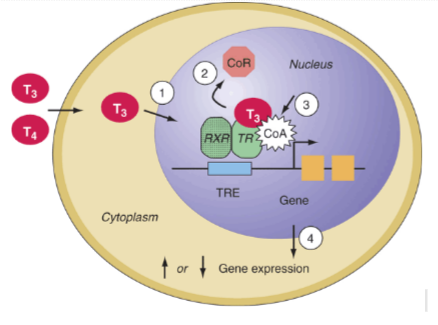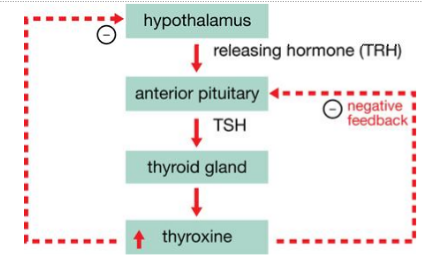#goitre
The Gland that has got a SecreteSecret
This article will focus on one of the more important glads of the human body; the thyroid. This article will focus on the anatomy and physiology, biochemistry and clinical aspects of the thyroid, hopefully giving our readers a better understanding of this organ.
The Thyroid
Situated on the ventral side of the neck, the thyroid gland is composed of two lobes: right and left that are situated anterolaterally to the trachea. It normally weighs 15 to 20 grams in adults (1), but despite its small size, it is responsible for producing two important bodily hormones.
Follicular cells in the thyroid gland mainly produce the prohormone thyroxine (T4), and a smaller amount of the active hormone, triiodothyronine (T3). Most T4 is converted to T3 in other tissues by thyroxine-specific deiodinase enzymes, activating it when it reaches its target site.

Figure 1. Showing the molecular structure of T3 (left) and T4 (right).
T3 and T4 from thyroid gland to target tissue
Synthesised T3 and T4 diffuse out of follicular cells and enter a blood vessel. Almost all secreted T3 and T4 circulating the bloodstream are bound to proteins; the major binding protein being thyroxine-binding globulin (TBG). A TBG-blood test(2) may be used to diagnose problems with the thyroid such as hypothyroidism, a clinical condition where insufficient production of thyroid hormone occurs.
Free T3 and T4 enter cells by active transport, an energy-dependent transport method. As discussed above, organ tissues with high blood flow (such as liver, skeletal muscles and kidney) possess enzyme deiodinase and catalyses most of the conversion of T3 and T4. Other tissues with low local T3 generation may depend on these tissues to obtain sufficient levels of T3.
At the physiological level
The most important role of thyroid hormones are to control basal metabolic rate (BMR). BMR refers to the basal rate of oxygen consumption and heat production. Normally, mitochondria generate energy by oxidative phosphorylation. During this process, the energy from protons (H+) moving down a proton gradient is used to generate ATP (the energy currency of the cell). This is a similar process to the momentum of water being harnessed by water wheels in old mills.However, a special type of protein, called the uncoupling protein (UCP), is found exclusively in brown adipose tissue (BAT). Mitochondria in these cells can provide an alternative pathway for protons to travel back inside the mitochondria, down their proton gradient. This alternative pathway results in no ATP production with the energy being dissipated as heat.(4)
In the cardiovascular system, thyroid hormones increase the gene expression for β1-adrenergic receptors in cardiac muscle cells and increase the responsiveness of these cells towards β adrenergic activity. The overall effect increases the force of myocardium contraction (positive inotropy) and rate of heart muscle contraction (positive chronotropy), increasing cardiac output and blood vessel dilation in the skin, muscle and heart. The hormone increases tissue sensitivity to beta adrenergic hormones, increasing the heart rate and force of contraction.
Thyroxine hormone also affects the other systems such as the respiratory system, skeletal system, reproduction and nervous system. However, the most important functions of thyroid hormone are the regulation of BMR, maturation and development of nervous system and increase responsiveness of tissue to adrenergic activity.
Mechanism of thyroid hormone
The steps below correspond to the numbers in Figure 2.
1) T3 diffuses into the cytosol and subsequently into the nucleus (8).
2)Thyroid hormone receptor (TR) is located in the nucleus prebound to DNA. TR usually dimerises with a retinoid X receptor (RXR) and this dimer recognises and binds at a specific site on DNA known as the Thyroid Response Element (TRE). TH binds to TR leading to the dissociation of co-repressors (Figure 2).
3)At the same time, recruitment of co-activators (Figure 2) occurs.
4)The TRE mentioned in step 2 is a segment of DNA known as the refulatory sequence, a segment of DNA that increases or decreases the expression of specific genes. In this case, when the T3 binds to the TR-RXR dimer, and the TRE may activate or repress the target genes.

Figure 2. Diagram shows a schematic diagram of the general biochemical action of thyroid hormones on the target DNA
Transcription is followed by RNA translation to form hundreds of new intracellular proteins. T3 changes the rate of expression for hundreds of genes and increases or decreases the production of structural and functional proteins which may be the key molecules in different metabolic processes. T4 also performs such function, but is less potent than its counterpart T3.
With such function, one can imagine just how important the level of thyroid hormone is in the regulation of different physiological processes and how this may impact upon health (9)
Regulation Of Thyroid Hormone Production And Secretion
A hormone with such varied functionality has to be regulated to ensure its adequately supplied to targeted organs. Such intricate control has to be performed by the “endocrine master”; the hypothalamus. The hypothalamus releases thyrotropin hormone (TRH), which stimulates the release of thyroid stimulating hormone (TSH) in the closely linked anterior lobe of pituitary gland. TSH is then transported in the blood where it binds to the TSH receptor on the thyroid gland. TSH speeds up the production and release of thyroid hormones, promoting the growth of the gland with the help of some other growth factors.
When thyroid hormone levels are in excess, circulating molecules act on the hypothalamus and pituitary gland to decrease TRH and TSH secretion respectively. The mechanism involved is a negative-feedback control mechanism. When TRH and TSH secretion decrease, so does the production and the secretion of thyroid hormones. The hormones drop until the optimal physiological level whereby the inhibitions on TRH and TSH secretion are lifted (Figure 3).

Figure 3. Image shows the regulation of thyroid hormone by the hypothalamus and pituitary gland in a negative-feedback loop.
Diseases Related To Thyroid Gland
T3 (Figure 1) contains three iodine atoms. The synthesis of thyroid hormones requires an adequate supply of dietary iodine. The recommended dietary allowance (RDA) for iodine in an adult male is 150µg and slightly higher in pregnant women, 220µg (5). Deficiency of this precursor leads to insufficient production of T3 and T4. The consequences of this are low levels of circulating thyroid hormones which cause an increase of TSH secretion from the pituitary gland interfering with the negative feedback. Increased stimulation of TSH increases the activity of the thyroid gland in an attempt to normalize thyroid hormone level (6). Consequently the gland grows larger than the normal size, producing a condition known as a goitre(Figure 4).
A goitre refers to the enlargement of the thyroid gland (Figure 4), this could be due to hypothyroidism or hyperthyroidism. Goitres are more common in population living in mountainous regions, where access to iodine sources such as seafood are restricted. Such dietary deficiency can be prevented by adding small amounts of iodine to table salt.

Figure 4. Image showing a patient presenting a goitre.
Conclusion
Hopefully after reading this article, you’re a little more in the know about the little gland secretlysecreting hormones to help you stay healthy. Next time you’re calorie counting or checking the nutritional content of your food, make sure that you’re getting enough iodine in your diet as it can ensure that you don’t end up with a large number of problems down the line.
Post link

